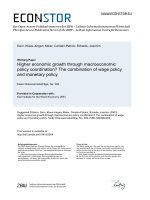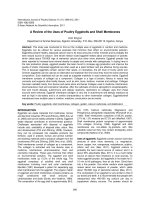The World at 7 Billion, and Growing Reuters doc
Bạn đang xem bản rút gọn của tài liệu. Xem và tải ngay bản đầy đủ của tài liệu tại đây (77.63 KB, 2 trang )
01 November 2011 | voaspecialenglish.com
The World at 7 Billion, and Growing
Reuters
Commuters at the Churchgate train station in Mumbai, India, on Monday, October 31
(You can download an MP3 of this story at voaspecialenglish.com)
This is the VOA Special English Health Report.
The United Nations estimates that the world reached seven billion people on
Monday. No one can be sure. The United States Census Bureau does not expect
that to happen until March.
Populations are growing faster than economies in many poor countries in Africa
and some in Asia. At the same time, low fertility rates in Japan and many
European nations have raised concerns about labor shortages.
Population experts at the United Nations estimated that the world reached six
billion in October nineteen ninety-nine. They predict nine billion by twenty-fifty
and ten billion by the end of the century.
China's population of one and a third billion is currently the world's largest. India
is second at 1.2 billion. But India is expected to pass China and reach one and a
half billion people around twenty twenty-five. India will also have one of the
world's youngest populations.
2
Economists say this is a chance for a so-called demographic dividend. India could
gain from the skills of young people in a growing economy at a time when other
countries have aging populations. But economists say current rates of growth,
although high, may not create enough jobs.
Also, the public education system is failing to meet demand and schooling is
often of poor quality. Another concern is health care. Nearly half of India’s
children under the age of five are malnourished. Sarah Crowe at the United
Nations Children's Fund in New Delhi says these two problems "could keep India
back."
SARAH CROWE: "That child is unable to really grow to its ability and will remain
in a state of stunting and not be able to learn when it goes to school when he
or she goes to school, and indeed later earn and really pay back and pay into the
economic and help the country and the region move forward. We have, you
know, out of every two hundred million children who start school, only ten
percent complete grade twelve."
Michal Rutkowski is the director of human development in South Asia at the
World Bank. He says the seven billionth person was likely to be a girl born in
rural Uttar Pradesh. Uttar Pradesh is one of India’s poorest and most crowded
states, with nearly two hundred million people.
He says reaching seven billion people in the world is a good time for a call to
action.
MICHAL RUTKOWSKI: "I think the bottom line of the story is that the public
policy needs to become really, really serious about gender equality and about
access to services to combat malnutrition, and to provide for access to health
services, water, sanitation, schooling."
And that's the VOA Special English Health Report. I'm Jim Tedder.
___
Contributing: Anjana Pasricha and Vidushi Sinha









